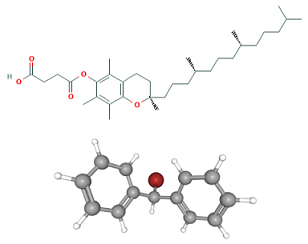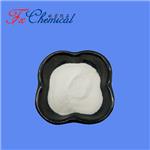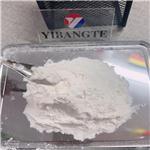Vitamin E succinate-Application
Vitamin E succinate is one of many substances known as an antioxidant. These substances help in the protection of your body’s cells. When you have an antioxidant in your system, unstable molecules called free radicals cannot penetrate your cells. This can help prevent you from getting cancer, MedlinePlus indicates.

Fig 1. Chemical structure formula and three-dimensional structure of Vitamin E succinate
Vitamin E Succinate takes vitamin E’s antioxidant action one step further, and may help bring vitamin E into and across cell membranes. Succinate feeds directly into the Krebs cycle, our major metabolic pathway for generating energy. This extra dimension from succinate significantly extends the protective properties of vitamin E. Then why not have vitamin E as succinate in all antioxidant formulations Because the succinate form of vitamin E is derived from soy. However, the amount of residual soy antigens in this product is very small. This form may enhance membrane integration of Vitamin E.
Vitamin E succinate (VES) is a derivative of the fat-soluble vitamin d-alpha-tocopherol or dl-alpha-tocopherol. The general term vitamin E refers to eight naturally occurring and synthetic tocopherols and tocotrienols and their acetate and succinate derivatives. D-Alpha-tocopherol succinate is the succinate ester of natural-source d-alpha-tocopherol. D-Alpha-tocopherol succinate is obtained by the vacuum steam distillation and succinylation of edible vegetable oil. Dl-Alpha-tocopheryl succinate is an all-synthetic form of alpha-tocopherol. It is produced by coupling racemic isophytol with trimethylhydroquinone to form dl-tocopherol.
Although the naturally occurring forms of vitamin E have lipid-soluble antioxidant properties that protect cell membranes against damage by free radicals, the acetate and succinate derivatives that are esterified at the C-6 position of the chromanol ring do not have antioxidant properties unless the esterification is hydrolyzed and free tocopherol is regenerated. The succinate form is water-soluble and the acetate form is fat-soluble. Vitamin E Succinate takes vitamin E’s antioxidant action a step further. Succinate feeds directly into the Krebs cycle, our major metabolic pathway for generating energy. This extra dimension from succinate significantly extends the protective properties of vitamin E[1-3].
Vitamin E succinate is may inhibit growth and induced apoptic cell death in estrogen-receptor-negative human breast cancer cell lines. Vitamin E succinate is a potent novel antineoplastic agent with high selectivity and cooperativity with tumor necrosis factor-related apoptosis-inducing ligand. Vitamin E succinate may be of clinical use in the treatment of aggressive human breast cancers, particularly those that are resistant to anti-estrogen therapy. Alpha-tocopheryl succinate can suppress the expression of prostate-specific antigen (PSA), a marker for the progression of prostate cancer. VES can also suppress androgen receptor (AR) expression by means of transcriptional and posttranscriptional modulation.
Vitamin E succinate enhances the immune response and induces cellular differentiation and/or growth inhibition. Patent Inhibitor of neuroblastoma. cells, murine melanoma cells, avian lymphoid cells, human HL-60 promyelocytic leukemia cells, and several human breast carcinoma cell lines. VES has been shown to modulate adenylate cyclase and cAMP-dependent protein, inhibit protein kinase C activity, bind to cellular vitamin E binding protein, suppress c-myc and c-H-ras oncogene expression, and regulate TGFb protein production[4,5].
References
[1]Turley J M , Ruscetti F W , Kim S J , et al. Vitamin E succinate inhibits proliferation of BT-20 human breast cancer cells: increased binding of cyclin A negatively regulates E2F transactivation activity.[J]. Cancer Research, 1997, 57(13):2668-2675.
[2]Yu W , Israel K , Liao Q Y , et al. Vitamin E succinate (VES) induces Fas sensitivity in human
);You may like
See also
Lastest Price from D-α-Tocopherol succinate manufacturers

US $0.00/KG2023-11-15
- CAS:
- 4345-03-3
- Min. Order:
- 1KG
- Purity:
- 98%min
- Supply Ability:
- 30tons/month

US $0.00-0.00/kg2023-08-02
- CAS:
- 4345-03-3
- Min. Order:
- 1kg
- Purity:
- 0.99
- Supply Ability:
- 50000kg


